

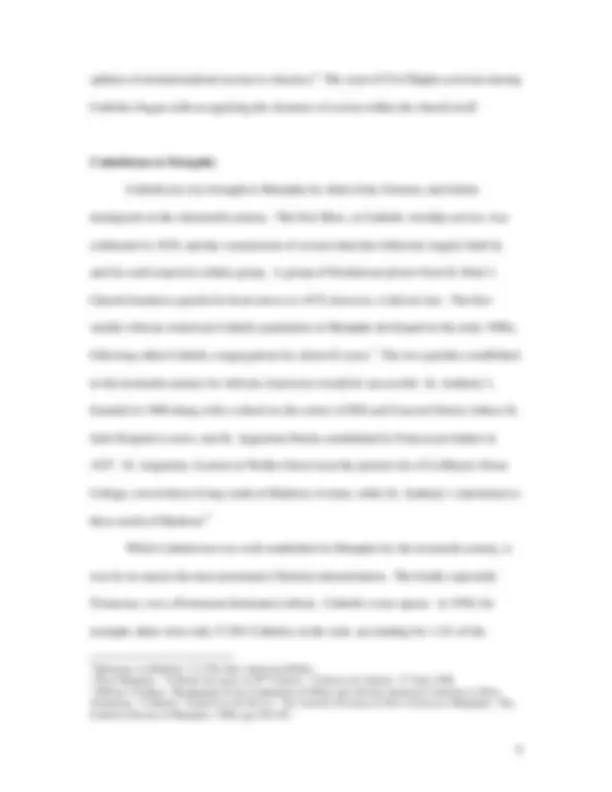
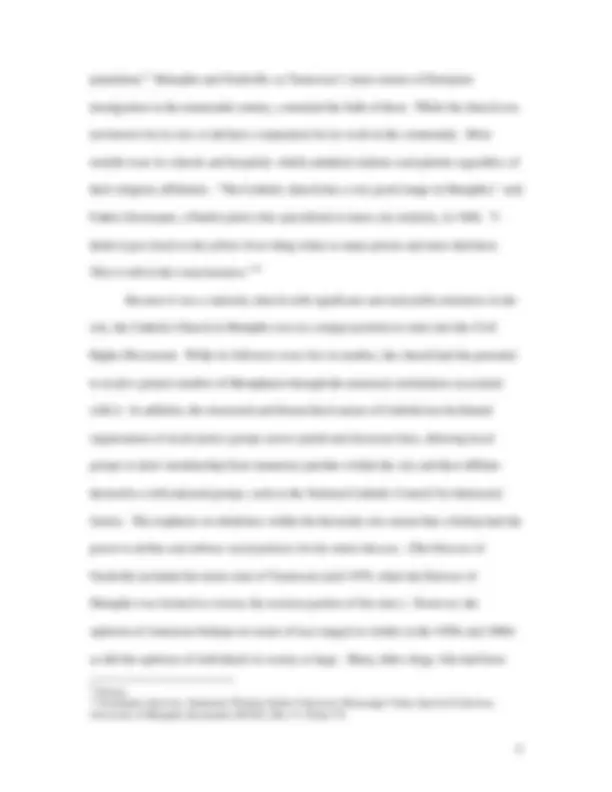




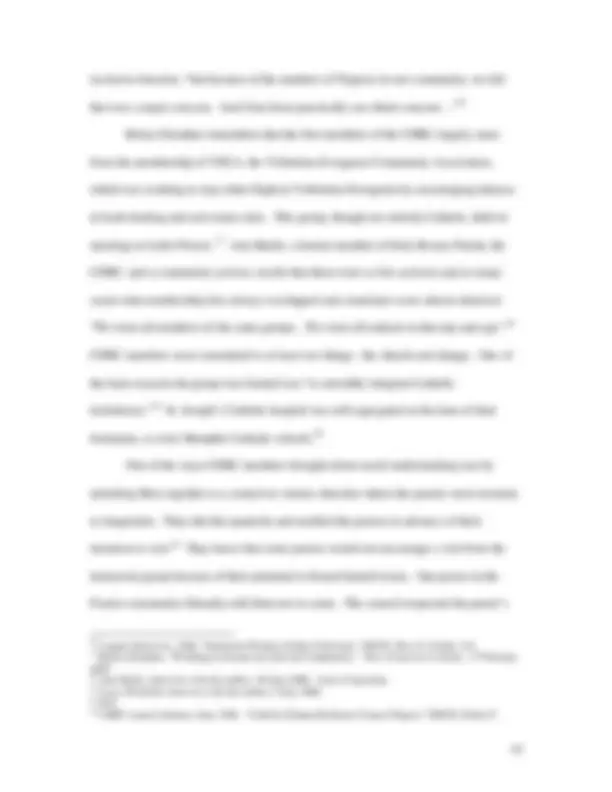

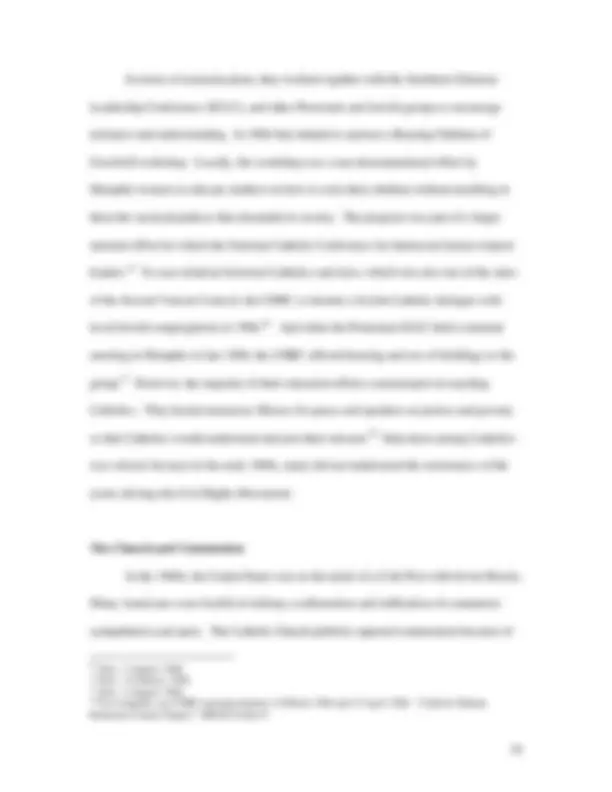
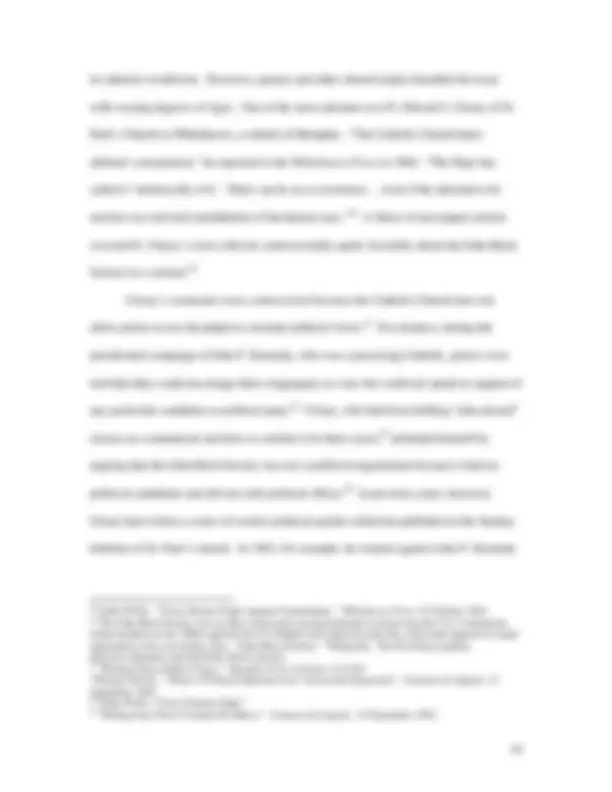


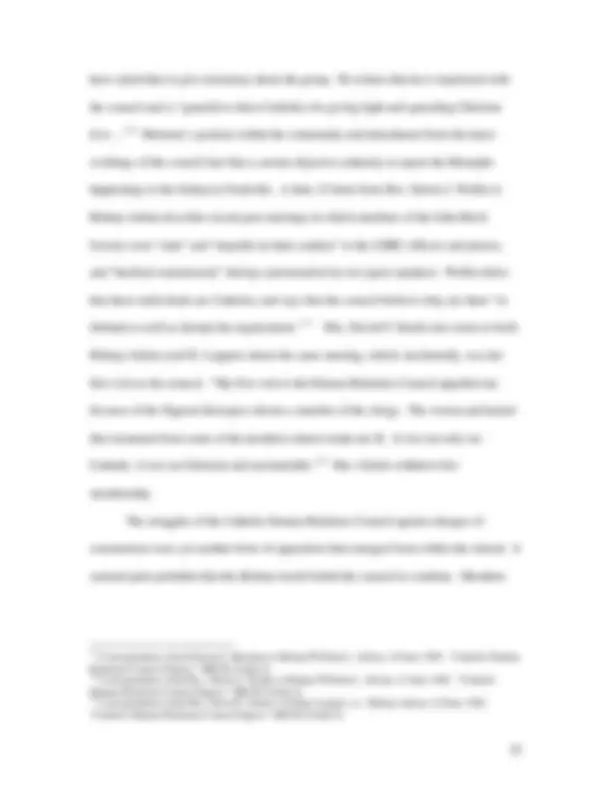
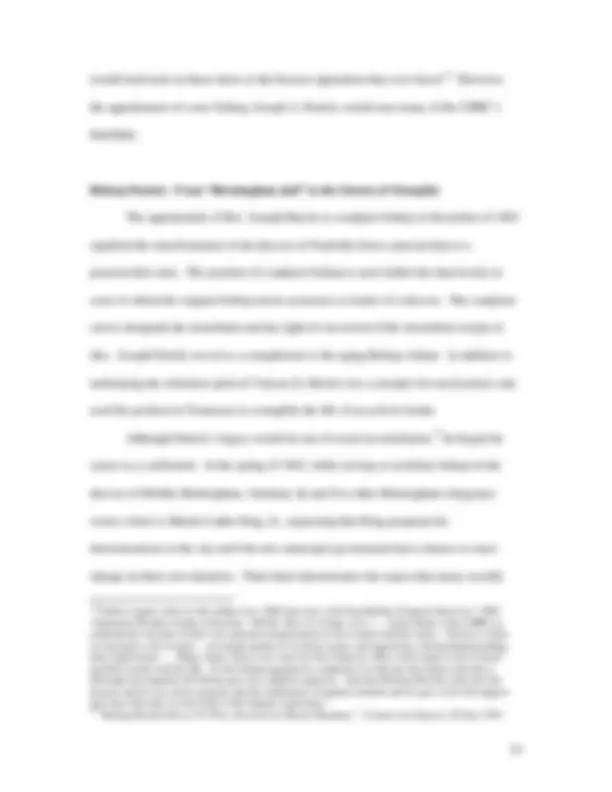

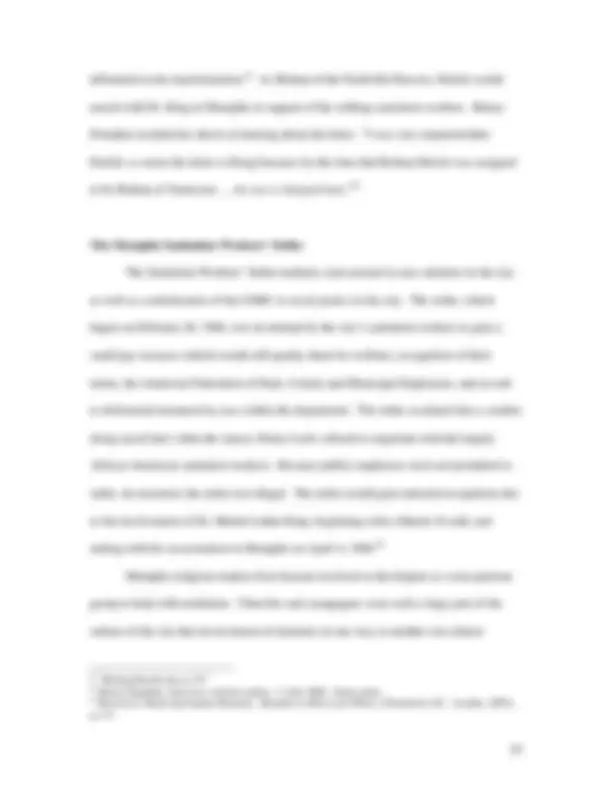
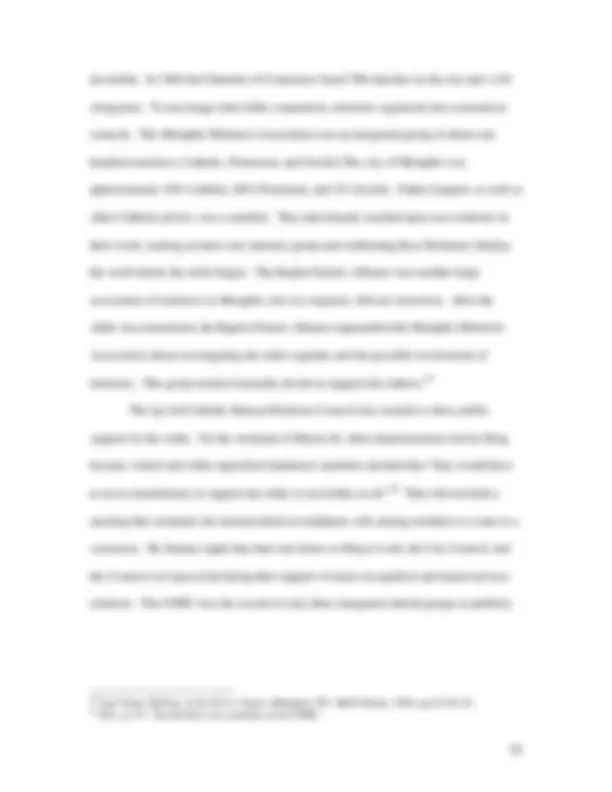
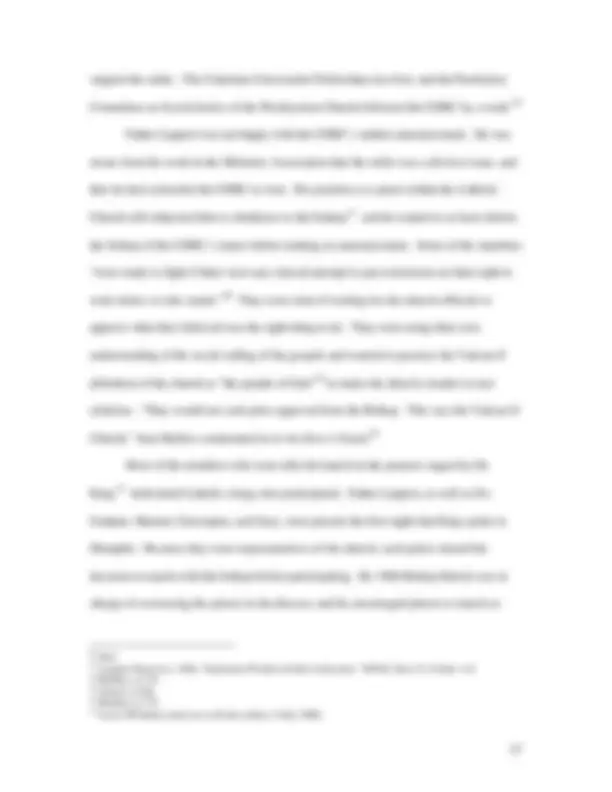

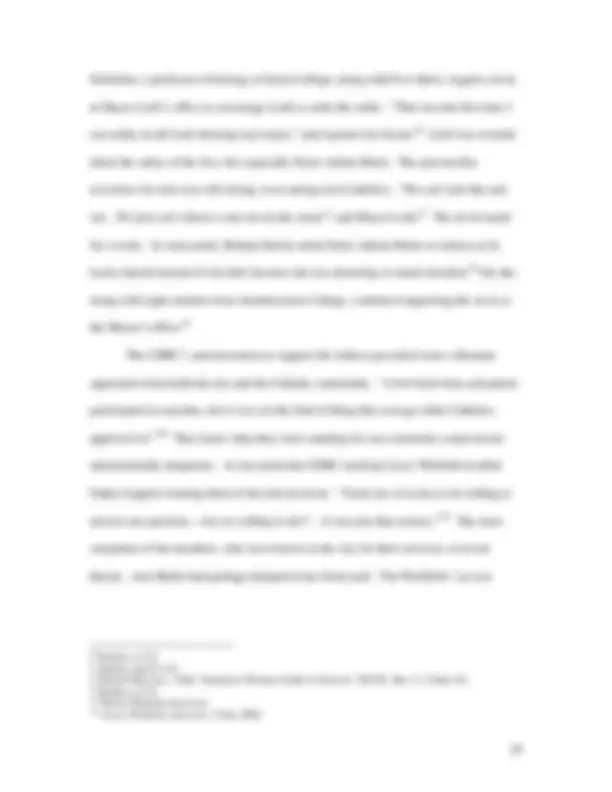
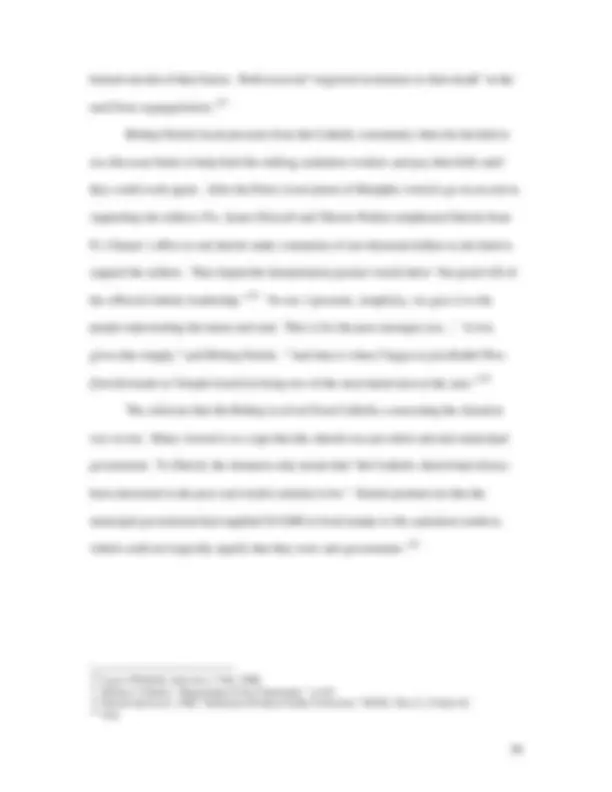
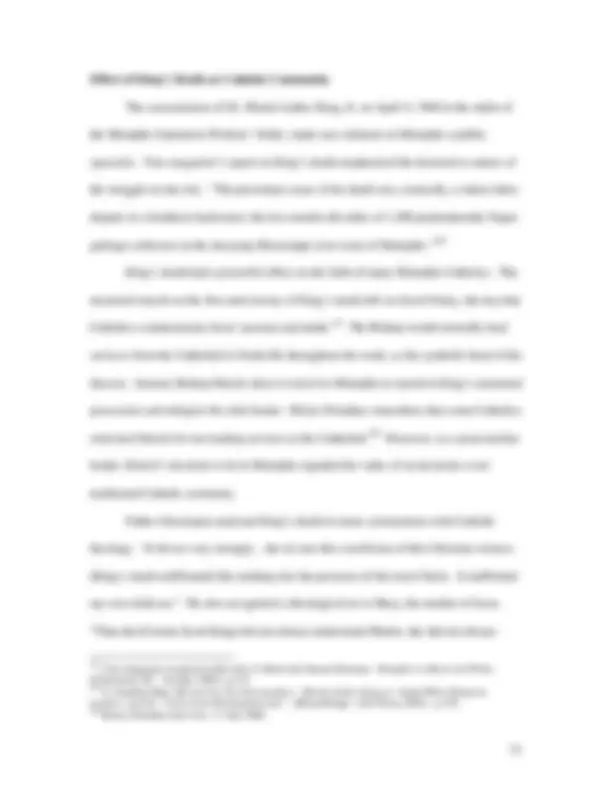

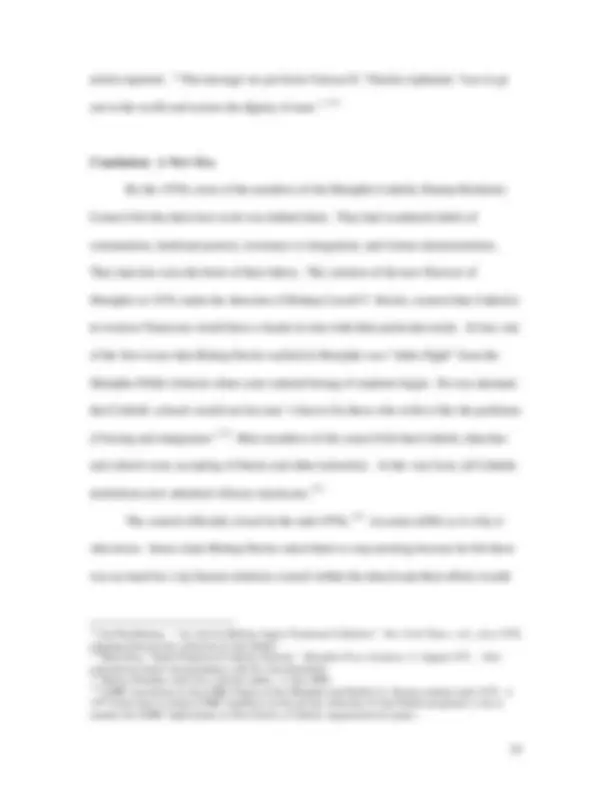



Study with the several resources on Docsity

Earn points by helping other students or get them with a premium plan


Prepare for your exams
Study with the several resources on Docsity

Earn points to download
Earn points by helping other students or get them with a premium plan
Community
Ask the community for help and clear up your study doubts
Discover the best universities in your country according to Docsity users
Free resources
Download our free guides on studying techniques, anxiety management strategies, and thesis advice from Docsity tutors
Material Type: Paper; Class: EAST EURASIAN MINORITIES; Subject: History; University: Rhodes College; Term: Unknown 1989;
Typology: Papers
1 / 34

This page cannot be seen from the preview
Don't miss anything!



























Supremely Human: The Civil Rights Activism of Memphis Catholics, 1961- Amy DeLong What does the Church think of man? What needs to be recommended forthe upbuilding of contemporary society? What is the ultimate significance of human activity throughout the world? People are waiting for an answer to these questions. From the answers it will be increasingly clear that the People of God and the human race in whose midst it lives render service to each other. Thus the mission of the Church will show its religious, andby that very fact, its supremely human character. 1
This passage from the Catholic Church’s 1965 statement on the Church in the Modern World encapsulates the struggles that not only the church, but also people throughout the United States were asking themselves as the Civil Rights Movement challenged them to reconsider injustices in modern society. In Memphis, a small group of Catholics applied their religious convictions about the dignity inherent in all humankind to further the cause of racial justice. In the process, they discovered the very human character, both positive and negative, of the Church as an institution. As Memphians struggled to undo decades of racial discrimination in the 1950s and 60s, members of the Catholic Church in Memphis struggled along with it, sometimes leading the way. Although Catholics comprised only 2.2% of the state’s population in 1966,^2 their activism had a significant impact on the Civil Rights Movement in Memphis. A motivated group of clergy and laypeople banded together in the Memphis Catholic
(^1) Second Vatican Council, Gaudium et Spes : Pastoral Constitution on the Church in the Modern world. 7 December 1965. Reprinted at the website of the Vatican, “Documents of the II Vatican Council.”http://www.vatican.va/archive/hist_councils/ii_vatican_council/documents/vat- ii_cons_19651207_gaudium-et-spes_en.html (^2) David M. Cheney, “Statistics, Diocese of Nashville,” www.catholic-hierarchy.org. http://www.catholic- hierarchy.org/diocese/dnash.html
Human Relations Council to work for change through causes including school integration, inner-city poverty, and the 1968 Sanitation Workers’ Strike.^3 The Church would have to come a long way, however, before it could set itself as an example in the crusade for racial justice. A series of theological changes, known collectively as the Second Vatican Council (1962-1965), helped to communicate the church’s social teachings in a way that encouraged activism among Catholics. In Tennessee, a change in church leadership exemplified this change in theology when in 1963 a new bishop, Joseph Durick, was appointed to the diocese. This new bishop, in decided contrast to the former leadership, embodied the reforming spirit of the Second Vatican Council and applied that spirit to the Civil Rights Movement. This essay examines the activism among Memphis Catholics in issues of racial justice and the religious forces behind their motivation. It argues that the conjunction of the Second Vatican Council and the Civil Rights Movement in American society was crucial in creating a culture of change within the church. Catholics looked both inward to examine problems in the church, and outward to address issues in the larger social order. Their work was as much about changing the church as it was about changing society. . Vatican II: A Theological Revolution American society underwent an upheaval in the years following World War II, and, in this regard, the Catholic Church was no different. Aware that the church’s liturgy and social teaching needed modernizing, Pope John XXIII convoked the Second Vatican
(^3) Catholic Human Relations Council Papers, Memphis and Shelby County Room, Memphis Public Library [hereinafter MSCR].
splinter of institutionalized racism in America.^6 The seed of Civil Rights activism among Catholics began with recognizing the elements of racism within the church itself.
Catholicism in Memphis Catholicism was brought to Memphis by white Irish, German, and Italian immigrants in the nineteenth century. The first Mass, or Catholic worship service, was celebrated in 1839, and the construction of several churches followed, largely built by and for each respective ethnic group. A group of Dominican priests from St. Peter’s Church founded a parish for freed slaves in 1875; however, it did not last. The first sizable African-American Catholic population in Memphis developed in the early 1900s, following white Catholic congregations by about 65 years.^7 The two parishes established in the twentieth century for African-Americans would be successful: St. Anthony’s, founded in 1909 along with a school on the corner of Hill and Concord Streets (where St. Jude Hospital is now), and St. Augustine Parish, established by Franciscan fathers in
(^67) Reference to Matthew 7:3 (The New American Bible). 8 Perre Magness. “Catholic ties grew in 20Milton J. Guthrie, “Beginnings of the Community of White and African American Catholics in Westth^ Century,”^ Commercial Appeal , 27 June 1996. Tennessee: A Sketch,” inCatholic Diocese of Memphis, 1996), pp.438-439. Between the Rivers: The Catholic Heritage of West Tennessee (Memphis: The
population.^9 Memphis and Nashville, as Tennessee’s main centers of European immigration in the nineteenth century, contained the bulk of them. While the church was not known for its size, it did have a reputation for its work in the community. Most notable were its schools and hospitals, which admitted students and patients regardless of their religious affiliation. “The Catholic church has a very good image in Memphis,” said Father Greenspun, a Paulist priest who specialized in inner-city ministry, in 1968. “I think it goes back to the yellow fever thing when so many priests and nuns died here. This is still in the consciousness.”^10 Because it was a minority church with significant and noticeable ministries in the city, the Catholic Church in Memphis was in a unique position to enter into the Civil Rights Movement. While its followers were few in number, the church had the potential to reach a greater number of Memphians through the numerous institutions associated with it. In addition, the structured and hierarchical nature of Catholicism facilitated organization of racial justice groups across parish and diocesan lines, allowing local groups to draw membership from numerous parishes within the city and then affiliate themselves with national groups, such as the National Catholic Council for Interracial Justice. The emphasis on obedience within the hierarchy also meant that a bishop had the power to define and enforce racial policies for his entire diocese. (The Diocese of Nashville included the entire state of Tennessee until 1970, when the Diocese of Memphis was formed to oversee the western portion of the state.). However, the opinions of American bishops on issues of race ranged as widely in the 1950s and 1960s as did the opinions of individuals in society at large. Many older clergy who had been (^910) Cheney, University of Memphis [hereinafter MVSC], Box 21, Folder 79.Greenspun interview, Sanitation Workers Strike Collection, Mississippi Valley Special Collection,
authority would have prevented much of the violence of the Civil Rights Movement.^14 At the same time that Catholic progressives were citing the life of Christ as an example of anti-establishmentarianism, Adrian used the Vatican II pronouncement of Pope Paul VI that renewal of the church should be brought about through “assimilating interiorly her true spirit of obedience to Christ” to argue for a greater obedience of laypeople to church clergy. He cited Romans 13:2, that “all lawful authority is from God,” and “He who resists this authority resists the ordinance of God; and they that resist, bring on themselves condemnation,” to explain that Catholics are bound to respect the authority of “the Pope, the Bishop, the pastor, the religious superior, the civil authority, the parent, and the teacher.”^15 Adrian’s view on racial justice is best conveyed in his policy towards Catholic school integration. After the 1954-1955 Supreme Court decisions ordering public school integration “with all deliberate speed,” Bishop Adrian knew that Catholic schools in his diocese would have to react. Corresponding to his views on obedience to authority, Adrian did not give his opinion, but instead proclaimed, “This is the law of the land, and it must be obeyed.”^16 Adrian was not an advocate of swift change. According to Stritch, he allowed the four deans, or head priests, of the Nashville Diocese to decide “how deliberate their compliance with the law would be,”^17 most likely with strong instruction from the bishop himself. In Nashville, plans for gradual integration did not begin until
(^1415) The Tennessee Register , 9 October 1964. 16 Ibid. Stritch, p.334. (^17) Ibid.
the spring of 1963 and culminated in the fall of 1966 with the integration of high schools.^18 In Memphis, integration of Catholic schools took even longer, with the first integration occurring in 1967 at St. Therese of Little Flower School Elementary School, and the first major integration of a high school in 1970 at Catholic High School.^19 Father Joseph Leppert, pastor of St. Therese of Little Flower Church at the time, was in favor of a faster and more intentional integration. “The bishop asked the pastors of Memphis to discuss the program of integration and the majority of them decided they would follow the plan of the public schools. A few of us were in the minority group, but we followed the decision of the majority…the bishop recommended that.”^20 However, when the African-American parish of St. Anthony’s closed in 1965, Father Leppert had his chance to informally integrate both his church and school by welcoming the members of St. Anthony’s to worship and fellowship with Little Flower Parish.
“A Strong and Determined Spirit”^21 : Father Leppert and Integration of Little Flower Parish Father Leppert’s decision to integrate St. Therese of Little Flower Parish in 1965 was radical, representing the first time a Catholic church in Memphis was intentionally integrated. Although, in Leppert’s words, “the church has been integrated always,”^22 meaning that blacks had never been barred from attending a white church, very few chose
(^18) Dr. Joan Zurhellen, Archivist of Diocese of Memphis. Email correspondence with the author, 10 July
of the members went to St. Augustine, the other black parish, where they felt more comfortable, but Fr. Leppert made sure to welcome them to Little Flower, and many decided to become members. “He saw this as what Christ would have done,” remarked one Little Flower parishioner.^25 “Monsignor [Leppert] said that he felt segregation was a moral issue…and that as Catholics, the church should not wait for the courts to desegregate all public accommodations in Memphis, but that the church should set an example… they should show the non-religious community that we wanted to do the right thing. His goal was to desegregate the church at Little Flower and every organization in the church.”^26
Fr. Leppert was not ignorant of the issues of racial justice outside of the church. Instead, he was wise to realize that at this point in time, his sphere of influence was greater within the church. By successfully integrating all the Catholic facilities and organizations under his control, he could prove that peaceful integration was possible, and use his parish as an example for others. He, and other members who supported integration, believed that this was one of the best ways to be a Christian witness in 1960s Memphis.
Reaction to Little Flower Integration The reaction from the white population of St. Therese of Little Flower parish was mixed. Some families showed their disapproval by discontinuing their monetary contributions or joining the white flight to the suburbs of east Memphis. Some who stayed, but did not support integration, simply did not speak to the African-American parishioners. “There was a lot of resistance,” Bettye Donahue remembers.^27
(^2526) Loyce Winfield, interview with the author, 5 July 2006. 27 Bettye Donahue, interview with the author, 11 July 2006. Ibid.
According to an article by Rev. Milton Guthrie in Between the Rivers: The Catholic Heritage of West Tennessee , there was quite a stir the first Sunday that a large number of African-Americans attended Mass at St. Therese. After they sat down, some white parishioners got up from their pews and moved to seats in front of them, reasoning that “No black person is going to be in front of me.” 28 These parishioners had become so accustomed to the “lawful” segregation which pervaded the American south that they could not see past skin color to accept even Catholic African-Americans as equals in the church. Before integration, St. Therese was one of the largest parishes in the city, but white-flight and integration took its toll and the parish population dropped significantly. Those who were against integration learned quickly that they would either have to learn to get along with African-Americans in their church or leave. “There were very heated discussions about the desegregation issue,” Donahue remembers. “People met in the cafeteria of the school, and there was yelling and screaming, that sort of thing. Monsignor [Leppert] was very calm and patient and didn’t let anything disturb him.” He remained firm throughout these meetings, explaining that the church would be desegregated, and “that’s all there was to it.”^29 Loyce Winfield was an atypical white Catholic in that she and her husband chose to go to St. Therese because of its commitment to desegregation. The Winfields had been active in Holy Rosary Parish, located on Park Avenue, but felt they “couldn’t give witness to what [they] believed in” at the “all white” parish. They bought property in the
(^2829) Guthrie, “Beginnings of the Community,” p.440. Bettye Donahue, interview with the author, 11 July 2006.
began to meet with Father Leppert in the early 1960s to discuss these issues. This group became the Memphis Catholic Human Relations Council when they affiliated with the National Catholic Council of Interracial Justice based out of Chicago, but at first they were simply an informal interracial group.^33 Undoubtedly, many Memphis Catholics who joined the Catholic Human Relations Council (CHRC) were influenced by the teachings and practices of Leppert. The first meetings were held at Little Flower Parish, but also included the pastor of St. Augustine Church, some St. Augustine parishioners, and some men from St. Anthony’s parish.^34 From the beginning, the council intentionally included Catholics of different races and backgrounds and from different areas of the city. The purpose of the Council, as stated in the CHRC Constitution, was “A) To promote an appreciation of man’s dignity among all the elements of our community, B) To teach interracial justice and charity and their practical applications, and C) To cooperate with public and private agencies in the pursuit of decent human relations.”^35 Their mission was highly educational and focused on productive change. They were far- sighted and knew that integration was only the beginning of the societal changes that the church and the wider community would have to deal with in the coming years. At the outset, however, black-white relations within the church were their main concern, because it was the most pressing issue. Fr. Leppert emphasized that this was not their
(^33) Leppert Interview, 1968, “Sanitation Workers Strike Collection,” MVSC, Box 22, Folder 144. Because the council began informally, there is no one conclusive date of their formation. Dates given in sourcesrange from 1961 to 1963. (^3435) Ibid. CHRC , Constitution , “Catholic Human Relations Council Papers,” MSCR, Folder B.
exclusive function, “but because of the numbers of Negroes in our community, we felt that was a major concern. And it has been practically our whole concern…”^36 Bettye Donahue remembers that the first members of the CHRC largely came from the membership of VECA, the Vollentine-Evergreen Community Association, which was working to stop white flight in Vollentine-Evergreen by encouraging fairness in bank-lending and real-estate sales. This group, though not entirely Catholic, held its meetings at Little Flower. 37 Ann Shafer, a former member of Holy Rosary Parish, the CHRC, and a community activist, recalls that there were so few activists and so many causes that membership lists always overlapped and sometimes were almost identical. “We were all members of the same groups…We were all radicals in that day and age.”^38 CHRC members were committed to at least two things: the church and change. One of the basic reasons the group was formed was “to smoothly integrate Catholic institutions.”^39 St. Joseph’s Catholic hospital was still segregated at the time of their formation, as were Memphis Catholic schools.^40 One of the ways CHRC members brought about racial understanding was by attending Mass together as a council at various churches where the pastors were resistant to integration. They did this quarterly and notified the pastors in advance of their intention to visit.^41 They knew that some pastors would not encourage a visit from the interracial group because of their potential to broach heated issues. One pastor in the Frazier community blatantly told them not to come. The council respected the pastor’s
(^3637) Leppert Interview, 1968, “Sanitation Workers Strike Collection,” MVSC, Box 22, Folder 144. 2005.Bettye Donahue, “Working to become the beloved Community,”^ West Tennessee Catholic , 17 February (^3839) Ann Shafer, interview with the author, 28 June 2006. Ann is Caucasian. 40 Loyce Winfield, interview with the author, 5 July 2006. Ibid. (^41) CHRC council minutes, June 1966. “Catholic Human Relations Council Papers,” MSCR, Folder F.
home in the district for the predominantly African-American St. Thomas parish instead of the majority-Caucasian Immaculate Conception parish. After several days of protests in which Turner was joined by other Catholics, as well as members of the NAACP, she enrolled Eric Michael in another desegregated Catholic school. She decided to stop the protests because she felt that “we have accomplished our purpose, namely, to publicize the extent to which deliberate injustice was leveled at a child, whose parents represented the real target.”^45 Other African-American students had been rejected from Immaculate Conception School earlier that summer. In June, Margaret Dichtel reported to the CHRC that two girls had been rejected. 46 Telephone calls to the school about the girls’ admission were not answered. The council wrote to Bishop Adrian about the problem, and in August both of the girls were admitted.^47 The redrawing of parish lines had effectually segregated parochial schools by race, but the work of the CHRC ensured that those students of color who lived within the official parish boundaries would still be allowed to attend the majority-Caucasian school. In the years before the official instructions came from the bishop to desegregate Catholic schools, the CHRC did what they could to publicize the problems of segregation in schools, such as the Immaculate Conception debate. The council also worked to eliminate racial discrimination in the hiring of teachers. In July of 1965 they discussed the need to hire “qualified negro teachers” for the still-segregated schools.^48 The following year they petitioned Bishop Durick, who had been appointed co-adjutor to help
(^45) “Catholic Mother Pickets School,” The Tri-State Defender , 11 September 1965. Also “School is Picketed,” (^46) CHRC meeting minutes. 4 June 1965. “Catholic Human Relations Council Papers,” MSCR, Folder F. Commercial Appeal,. 2 September 1965. Dichtel was Caucasian. (^47) Ibid .. 6 August 1965. (^48) Ibid. , 9 July 1965.
Bishop Adrian, asking him to write a letter to all pastors in the diocese encouraging them to observe the federal equal opportunity employment policy and place special emphasis on hiring African-American teachers.^49 Bishop Durick responded to their request, instructing all Catholic schools in the diocese that racial discrimination would not be permitted in the hiring of teachers.^50 The council also encouraged the education of African-American students who would not normally be able to attend Catholic schools by providing scholarships.^51 The CHRC also supported issues that would affect the larger community, such as fair housing policies and inner-city poverty. In 1965 they took on improvement of the Fowler Homes housing project, organizing a day care center for the 1400 children living in the area. Later in the year they led a food drive and Thanksgiving celebration for residents.^52 Fair housing had always been one of their concerns, from the beginning of the council in the Vollentine-Evergreen neighborhood. The council tried to curb white flight by recruiting Catholic real estate agents to support open housing. Through fair policies in real estate sales, they hoped to shape attitudes of white residents so that “panic selling” would not occur.^53 To support this issue through legislation, they petitioned Tennessee Congressmen Robert Everett and Thomas Murray to back passage of the Fair Housing Bill,^54 (the bill would eventually be passed into law in 1968, after the death of Martin Luther King, Jr. brought greater attention to the Civil Rights Movement).
(^4950) Ibid ., June 1966. 51 Ibid.Ibid. , 8 July 1966., June 1966. (^5253) Ibid. , 10 September 1965, 12 November 1965, 10 December 1965. 54 Ibid.Ibid., , 14 July 1967. 1 July 1966.
its atheistic worldview. However, pastors and other church leaders handled the issue with varying degrees of vigor. One of the most adamant was Fr. Edward J. Cleary of St. Paul’s Church in Whitehaven, a suburb of Memphis. “The Catholic Church hates atheistic communism,” he reported to the Whitehaven Press in 1964. “The Pope has called it ‘intrinsically evil.’ There can be no co-existence… even if the alternative be nuclear war and total annihilation of the human race.”^59 A flurry of newspaper articles covered Fr. Cleary’s views after he controversially spoke favorably about the John Birch Society in a sermon.^60 Cleary’s comments were controversial because the Catholic Church does not allow priests to use the pulpit to circulate political views.^61 For instance, during the presidential campaign of John F. Kennedy, who was a practicing Catholic, priests were told that they could encourage their congregants to vote, but could not speak in support of any particular candidate or political party.^62 Cleary, who had been holding “educational” classes on communism and how to combat it for three years,^63 defended himself by arguing that the John Birch Society was not a political organization because it had no political candidates and did not seek political offices.^64 In previous years, however, Cleary had written a series of overtly political epistles which he published in the Sunday bulletins of St. Paul’s church. In 1963, for example, he warned against John F. Kennedy
(^5960) Sallie Willis. “Cleric Pursues Fight Against Communism.” Whitehaven Press , 22 October 1964. Some members in the 1960s opposed the Civil Rights movement because they associated appeals for equalThe John Birch Society was an ultra-conservative group dedicated to preserving the U.S. Constitution. opportunity with a socialistic state. “John Birch Society,” Wikipedia: The Free Encyclopedia.http://en.wikipedia.org/wiki/John_Birch_Society (^6162) “Bishop Clears Father Cleary,” Memphis Press-Scimitar , 9-19-64. September 1964.Eleanor Kelley, “Pastor’s Political Opinions Can’t Always Be Expressed,”^ Commercial Appeal , 12 (^6364) Sallie Willis, ”Cleric Pursues Fight.” “Bishop Says Priest Violated No Ethics,” Commercial Appeal , 19 September 1964.
and his program of social liberalism, claiming that the president is “leading us into Socialism.”^65 Since the bishop is the ultimate authority when it comes to managing the priests in his diocese, Bishop Adrian had the power to censure Fr. Cleary. However, the conservative bishop condoned Cleary’s outspoken views on the Birch Society instead. “Is the John Birch Society a political organization?” the bishop asked in a letter responding to the debate. “You answer that. It is an open question.” To further absolve Cleary of any wrongdoing, he added that popes have “urged our bishops and priests to instruct our people on the evils of communism.”^66 Bishop Adrian’s apparent support for Cleary and members of the John Birch Society would impair the relationship between the Catholic Human Relations Council and the bishop when, in the following year, the CHRC itself would come under attack by members of the John Birch Society.
The Catholic Human Relations Council Under Attack The Catholic Human Relations Council was a group fighting to change the establishment. As such, they were vulnerable to being labeled communist sympathizers. Loyce Winfield remembers that CHRC member Ann Shafer was labeled as a communist because she was outspoken against Fr. Cleary’s support of the John Birch Society.^67 The persecution she faced from Fr. Cleary gave Shafer more reason to persevere. “Cleary, then, gets down on us in the CHRC because we were organized to oppose him,
(^65) “The Epistle of the Pastor to the Parishoners of St. Paul,” Parish Bulletin of St. Paul’s Catholic Church, November 3, 1963. (^66) “Bishop Says Priest Violated No Ethnics.” (^67) Loyce Winfield, interview with the author, 5 July 2006.